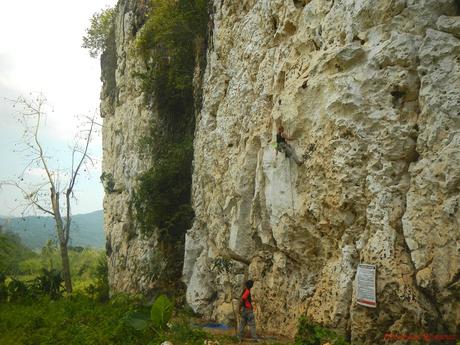
The popularity of sport climbing in Cebu—and in the Philippines, as a whole—has been slowly but steadily picking up. That is no surprise at all as we are blessed living in a lush, beach-filled, tropical paradise with numerous limestone cliffs that have the potential of becoming world-class climbing areas. In fact, we have one of the best climbing areas in the Philippines, which is located in Cantabaco, Toledo. Now, we have a new one, which is just 15 minutes away from that classic crag.
Sweetie and I, together with a small team of local climbers and guides, re-discovered an abandoned crag in Poog almost a year ago. After testing the rock through trad climbing, we concluded that it was the perfect candidate for a new rock climbing destination.
Through the generous donations of Ascanio Combria and Matthew Brooks, the bolting efforts of Enie Yonson and his team, and Gretchen and Willard’s talks with the Poog LGU, they were able to initially equip the white-rock Poog crag with more than 20 routes. Now, the beautiful Poog crag is open for everyone who wants to try out the adrenaline-pumping sport of rock climbing.
The road that leads to the crag is not difficult to spot; it is just beside the highway anyway. But for first timers, it can be tricky. Tell the driver you are heading to Poog. Once the bus turns left at the Uling-Toledo-Lutopan crossing, keep your eyes on the left side of the highway until you see this group of stores surrounding an inner road.
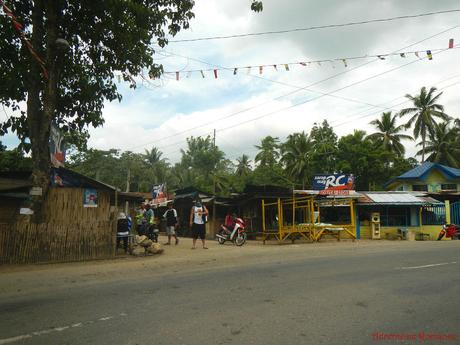
After buying your lunch, snacks, and beverages in any of the roadside stores, you can hike to the crag if you want to; it’s a great warm up exercise. But if you feel a bit lazy, you can ask a habal-habal driver to take you to the crag. Fare is P10 per person.
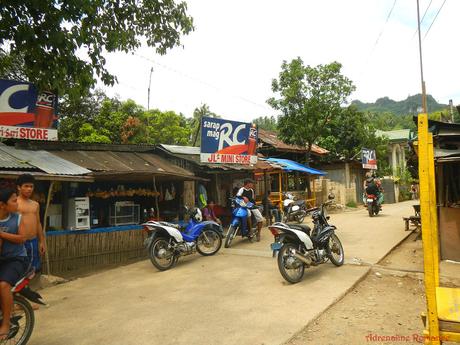
When we visited the Poog crag almost a year ago, this road was really bumpy and dusty. Now, it is nicely cemented. Way to go, LGU!
You will know you’re near when you see a huge crag looming ahead of you.
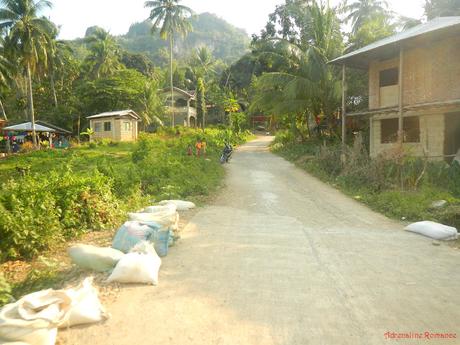
Ask the habal-habal driver to drop you off at this house, which is located right beside a blind road curve. That’s the entrance to the crag, and the dirt road beside it leads to the site. The road is wide enough so that you can drive your motorcycle, if you have one, to the cliff.
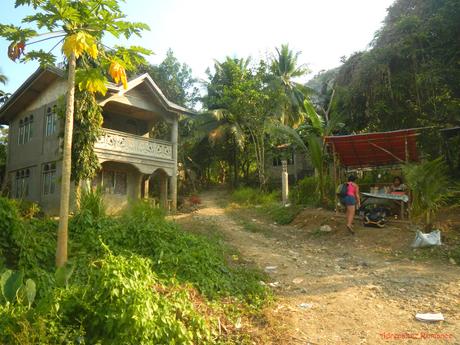
Forgot to bring some snacks? Want to have a snack to re-energize yourself after a tough climb? You can buy some delicious, spicy tempura and fish balls (common street food in the Philippines) at the little shed near the house. Don’t worry about having to endure a long hike; it’s just 5 minutes away from the crag.

Just follow the trail that cuts across a meadow and a light coconut grove.
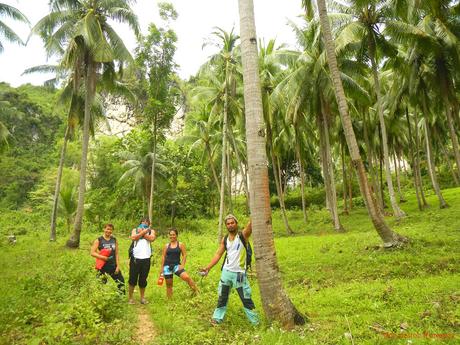
Then suddenly, this incredibly beautiful, gnarly white limestone cliff greets you! The rock face is even whiter than that in Cantabaco! As you can see, it has plenty of features that make climbing this crag interesting and enjoyable.
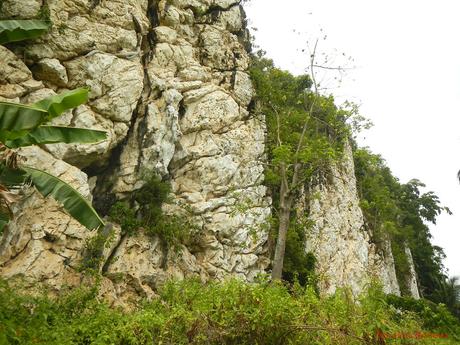
The large, long crag is divided into several climbing areas. Here, Sir Enie, one of our climbing guides and instructors, scales a route in Area 1. From the photo below, you can see just how massive this crag is. And that’s only one area! Area 1 has four routes ranging from YDS 5.9 to 5.11.
Area 1 also has a nice cave which exits to a “terrace” where you can take great on-cliff photos of climbers.

The routes are properly equipped with hangers that are fastened with stainless steel expansion bolts. There are also plenty of huecos and through-and-throughs that allow slings and ropes to be tied around them to act as protection. This is a cost-friendly move as slings and slung ropes are cheaper than bolts and hangers.

There are more climbing areas here. The whole length of the rock face in the photo below is filled with climbing routes.
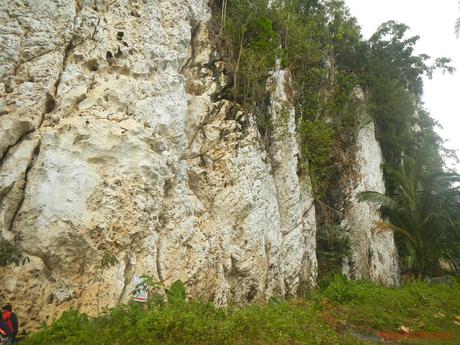
The belay area is flat and spacious, which is really good since it can accommodate more belayers and equipment. As you can probably tell, the locals have done a great job in clearing the area of vegetation.
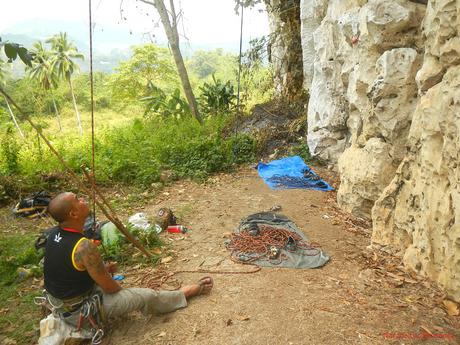
Let’s check out the climbing areas themselves.
When preparing, cleaning, bolting, and climbing new routes, lose rocks usually fall off the crag as they are subjected to weight and shock. These are some of the huge chunks of rocks left behind while the crag was being developed.
Rocks falling off and knocked loose in a newly developed and climbed crag are a normal occurrence. That’s why it is strongly recommended to wear helmets; a chunk of rock can fall off and hit someone at the belay area. Spectators are advised to stay clear of the belay area to avoid such accidents.
In a few months time of regular climbing, all loose rocks will have fallen off, and the entire cliff will be stabilized.
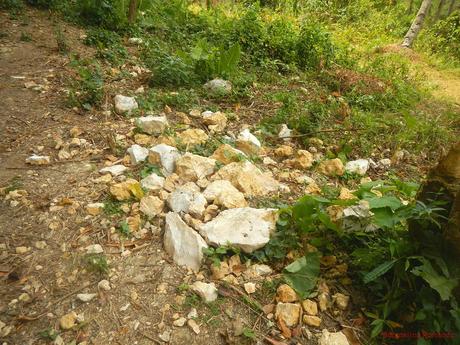
The Poog crag is known to be one of the most gnarly rock faces in Cebu. In fact, you can see how gnarly it really is if you stand close to the rock face and look up.
Its features make Poog an ideal crag for novice climbers; the gnarls are actually bumps, burrs, and holes that make great handholds and footholds.

Area 2 is the newest bolted climbing area with 6 routes ranging from YDS 5.9 to 5.10. Those are the perfect grades for first-time and newbie climbers because they offer a fun challenge. For intermediate and advanced climbers, they are excellent warm-up routes.
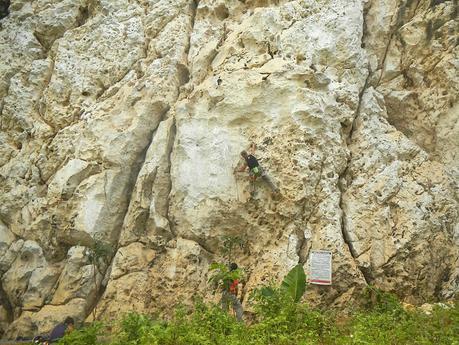
Okay, you’re now effectively warmed up. It’s time to proceed to Area 3, nicknamed the Candy Crash wall because the 6 routes here are named after popular Filipino candies. Graded from 5.10 to 5.11, these routes are amazingly sweet to climb just like their namesakes.
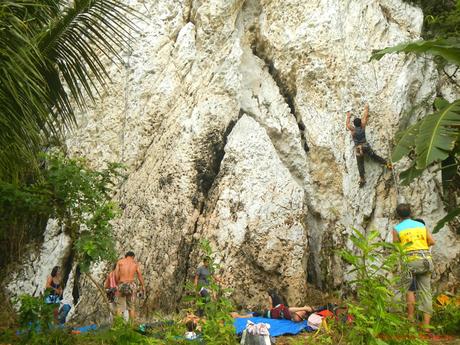
We tried out an Area 3 route called Tira Tira, first ascended by our good friend and climbing-equipment supplier and Se7en owner Jessie Singson. With only 4 points of protection, it looks deceptively short and easy. However, the route has poor feet (i.e. awkward footholds) and is slightly overhung, making it really pumpy (i.e. tiring) and challenging to ascend.
After seeing me successfully sending Tira Tira but sweating buckets and breathing like a locomotive, he couldn’t help but giggle and remark, “You thought it was easy, did you?”
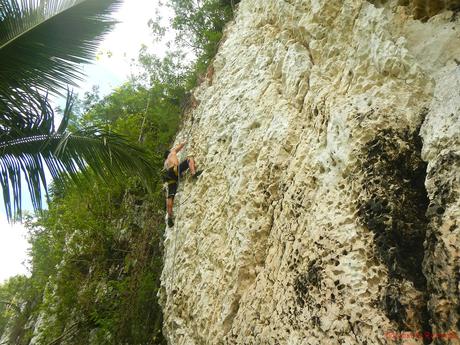
Just check out how sweaty I am! I was totally drenched after climbing Tira Tira! Hehehe! Sweetie got challenged and climbed the tricky Tira Tira after me. And just like everyone whom Jessie encouraged to try out Tira Tira, she huffed and puffed and strained to reach the anchor.
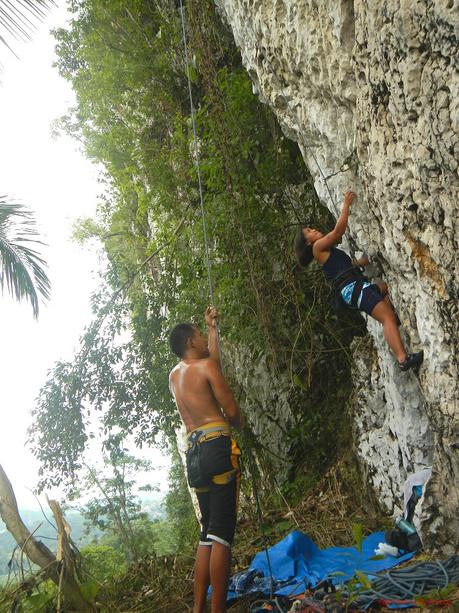
Numerous horns, holes, and protrusions along the crag make perfect hooks and tie-in points where you can hang bags, harnesses, climbing equipment, and other stuff that you don’t want on the ground.
You might also notice that some sections of the crag, especially in the lower areas, are powdery black. Well, that’s because in the past, locals used to burn trees and dry grasses here; this practice is called kaingin. Over time, the soot became embedded in the rock, giving it a characteristic dark color.
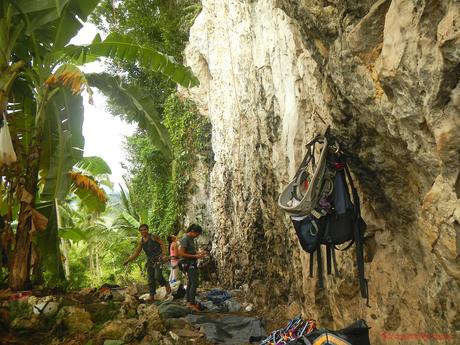
There are some sturdy trees across the holey crag. They make perfect anchors for hammocks! Just look for a hole in the crag and tie your hammock through. Time to catch a few zzzzzs!
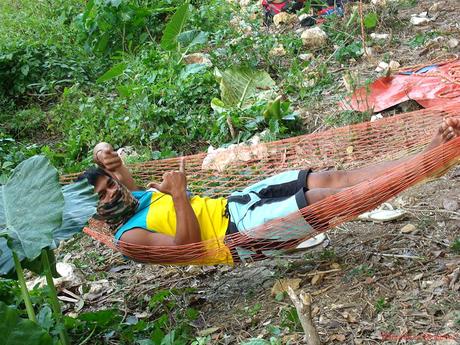
(Photo credit: Mary Grace Traya Cuizon)
Area 4, nicknamed the Captain’s Wall, is, for now, the last area that is equipped with hangers and bolts. With a massive and imposing horn at the top of the route, it’s the highest climbing area in Poog. YDS grades range from 5.10bs to 5.11bs, which means, they provide climbers a nice challenge.
Why Captain’s Wall? Well, let’s just say the routes are named according to everything that involves ships and airplanes.
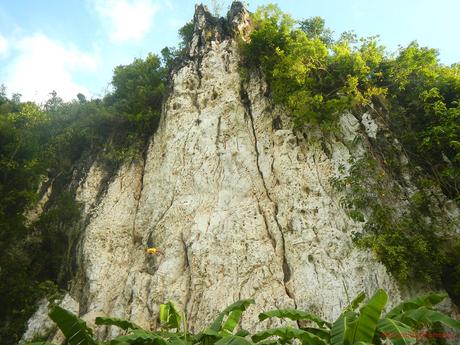
Below is a photo of the base of Captain’s Wall, which is quite shady and cool (the photo above is just half of Captain’s Wall). That little cave near the tarp is the crag’s natural changing room as well as a rain shelter.
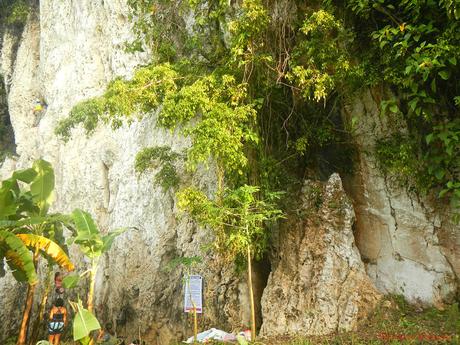
Our good friend Apol tries out Economy, the first half of an extended route that goes all the way to the top of the spire of Captain’s Wall. Check out the rock wall’s surface; it’s full of holes and depressions! Now that’s what we call a crag with acne! Hehehe!
Those holes are actually deceptive. Yes, they may look like excellent handholds, but many of them are simply smooth depressions that cannot be gripped comfortably.
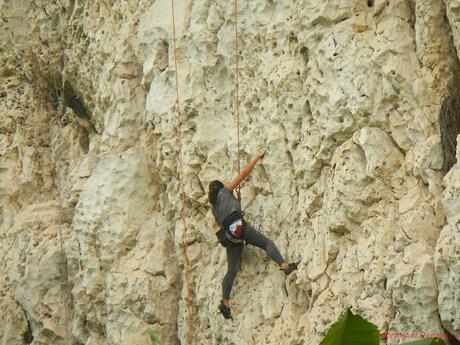
Our hearts always quake with excitement when someone attempts a first ascent of a newly bolted route. A valid first ascent happens when the person successfully lead climbs the route without falling. The first ascender of an unnamed bolted route will be given the honor of naming and grading that route.
Here, we cheered on as Jessie makes a successful first ascent of a route he calls Team Se7en, named after the small-scale outdoor shirt business that he is running. He graded the route at a respectable 5.10b.
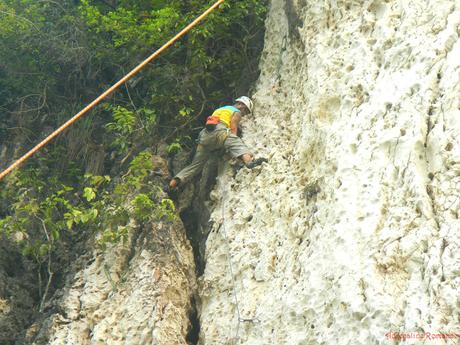
At the rightmost side of Captain’s Wall is another huge wall of great potential. Our good friend and fellow climber Ascanio together with Enie are going to bolt this crag. In fact, Ascanio has brought 500 bolts and hangers from Italy. These will be enough to equip 40 to 50 more new routes! Wow!
At present, we are in the talks with the LGU and the property owner so we can start clearing the area of vegetation.
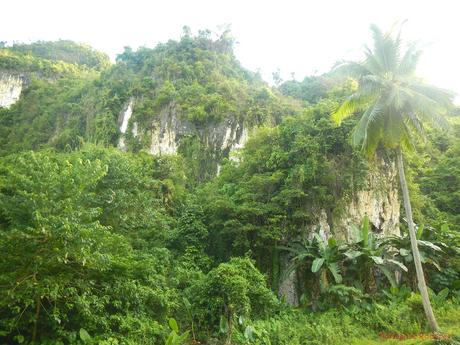
Flat spaces adjacent to the belay areas are perfect places where climbers can have a break or watch their fellow climbers scale the crag
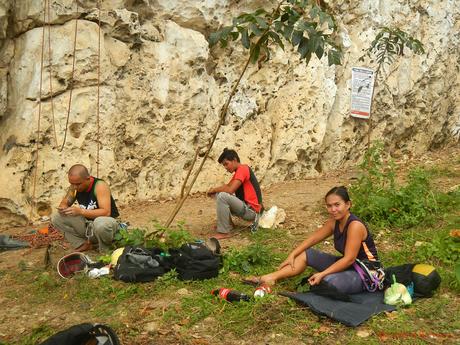
In fact, these spaces are large enough so climbers can park their motorcycles. There are also flat pieces of land where climbers can set up a picnic. The grassy area forms a soft and comfortable “bed” for your mats.
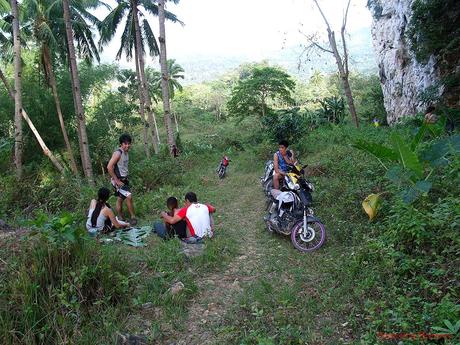
(Photo credit: Mary Grace Traya Cuizon)
The Poog Crag is located in a large open plot. This is great as you can see nice views as you ascend a route.
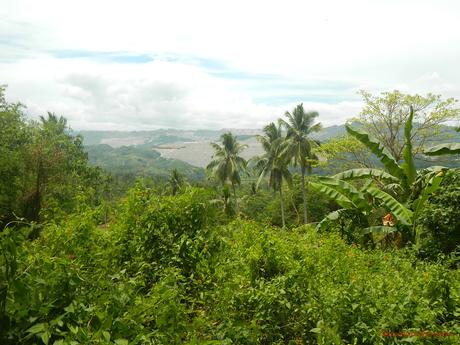
In addition, the expansive plot allows spectators and resting climbers to view the crag at its entirety. For nature and sports photographers, this is really a boon.
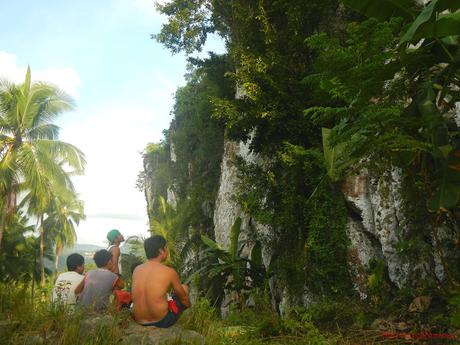
The large, flat, and even space also allows climbers to set up camp there. The crag acts as a natural windbreaker and shelter so campers are protected from extreme weather.
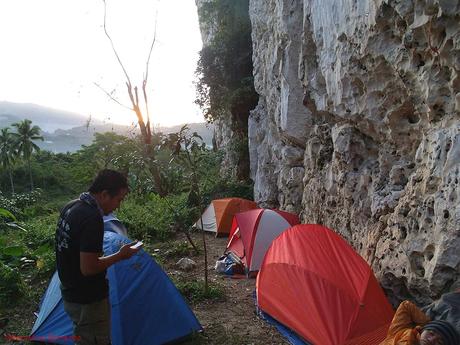
(Photo credit: Mary Grace Traya Cuizon)
A fun, busy day at the crag! Visit Poog right now, and experience the joy and excitement of ascending Toledo’s newest rock climbing site.
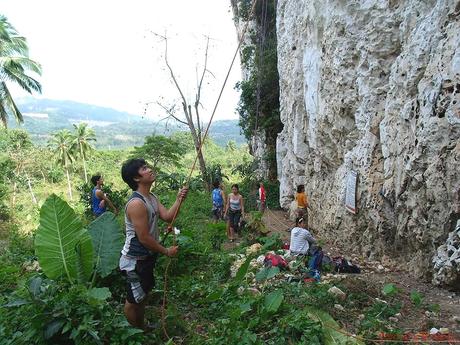
(Photo credit: Mary Grace Traya Cuizon)
Special Thanks
We would like to thank the following special people who largely contributed to the development of the Poog Crag:
- Ascanio Combria for generously donating the bolts, hangers, chains, and slings needed to equip the 20-plus routes in Poog
- Enie Yonson, Ascanio, and the rest of the bolting team for properly equipping the routes
- Matthew Brooks for donating bolts and hangers
- Gretchen Yagonia and Willard Elemino for faithfully doing the negotiations with the Poog LGU
- The Barangay Poog LGU for allowing us to develop the crag as well as taking care and cleaning the area
Topo
Here is the topo for the Candy Crash Wall and Captain’s Wall. We are still mapping out the topos for Areas 1 and 2; we will update this section as we receive them from the guides. Copy and print the topos for your personal use only!
Special thanks to Enie Yonson for making these topos.
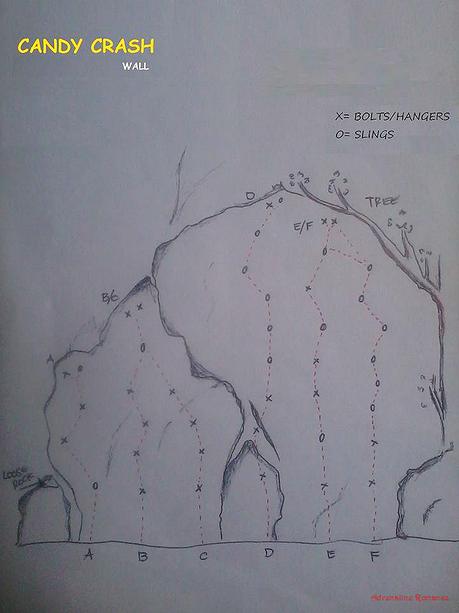

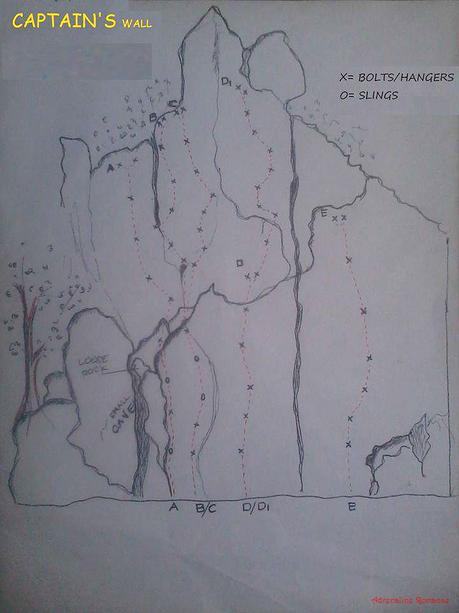

Budget Per Person*
- P 40 – non-aircon bus fare Cebu South Bus Terminal to Upper Poog-Toledo Highway crossing (same rate applies on the return leg)
- P 10 – habal-habal fare from Upper Poog-Toledo Highway crossing to Upper Poog (same rate applies on the return leg)
- P 100 – v-hire fare from Citilink Terminal to Upper Poog-Toledo Highway crossing. (same rate applies on the return leg). If you’re lucky, you can hail a V-hire coming from Toledo at the crossing. But most likely, V-hires passing by the crossing will be full. You need to ride a habal-habal or a bus that goes all the way to Toledo City. From Toledo, ride a v-hire that goes to the Citilink Terminal.
- P 5 – entrance fee to the crag
- Guide fee – please negotiate with the local guides.
* Unless indicated, these rates are in a per-person basis. We did not include our expenses for meals, snacks, tips, and other fees in this rate sheet as you may have different needs, preferences, itineraries, miscellaneous transportation, and sharing scheme from us. Note that all figures are subject to change without prior notice.
Tips
1. Poog Cliff is very accessible. Take a Toledo-bound bus at the Cebu City South Bus Terminal. Ask the conductor to drop you off at the Upper Poog-Toledo Highway crossing at the left side of the highway. Your landmark is a sari-sari store named Rosita’s Store. Disembark from the bus, and take a habal-habal to Upper Poog.
You can see the cliff when you reach the unfinished part of the road. Get off at the gray, concrete house by the road.
2. Alternatively, you can take a V-hire at the Citilink Terminal in Cebu City rather than the bus. Once you get to the Poog crossing, follow the directions above.
3. Ask permission from the property custodian before climbing the cliff. The custodian resides in that grey, two-story concrete house beside the trail that leads to Poog cliff.
4. Climbers are supposedly required to visit the Poog town hall to register and pay the entrance fee. This is still highly recommended, but officials must have realized that this is quite inconvenient for the climbers. Thus, they assigned a local there to record your presence and collect the fee. He patrols the area regularly, and he brings a record book with him.
5. Take note of the climbing rules in the Poog Crag
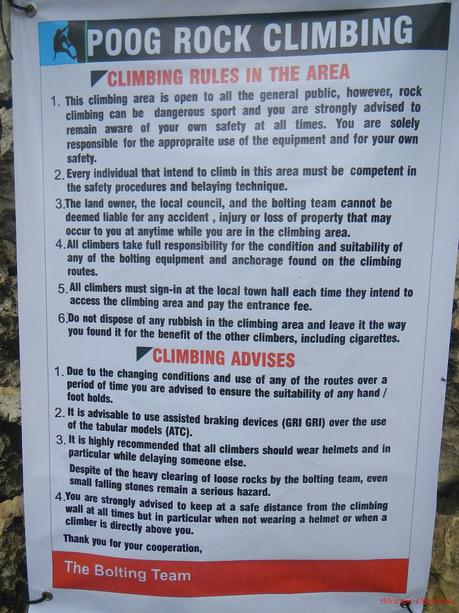
6. Please note that there are no local guides in Poog. For guideship services, contact Cantabaco guides Enie Yonson (0948-7124875), Willard Elemino (0947-9220289), or Gretchen Yagonia (0908-5815005). You can also look for them in Facebook under the group Cantabaco Climbing Friends. Note too that you have to shell out for their transportation since they live in Cantabaco.
7. Bring your own rock climbing shoes, harness, and other equipment. If you don’t have them, you can rent equipment from the Cantabaco guides at affordable rates.
8. For your lunch and snacks, you can buy your food before heading to the cliff. There are a lot of stores and eateries nearby where you can buy your meals and drinks. It is quite exhausting if you have to go back down from the crag to buy lunch.
9. Unless you have a private vehicle, it is best to exit the crag early in the afternoon (around 3 PM) and head to the highway. This is especially true on Sundays. It will be difficult to catch a ride late in the afternoon because people from Toledo who are going back to the city to prepare for the work week will fill up buses and v-hires to the brim.
Important Note
Just because the photos look cool and fun does not mean that you can take climbing lightly. Climbing is inherently DANGEROUS! Every time you climb, your life and the life of your partner hang in the balance. There are only three things that will happen in climbing: you succeed, you get seriously injured, or you die. Your safety depends on you and SOLELY on you! Thus before you go out there, it is vitally important that you get some basic training on climbing principles, techniques, and safety first.
Visit a local indoor climbing gym to practice for a few sessions before heading out to the big rock wall. You should also get training from professional guides. Although blogs (including ours), books, tutorial videos, and articles could be a good source of information, you should find a certified climbing instructor to properly coach you through the sport. We got our training from Cantabaco’s guides and climbing instructors, and even if then, we’re still learning. Let us be clear on one thing: we are NOT climbing instructors.

